A Compact Ultra-Thin 4 × 4 Multiple-Input Multiple-Output Antenna
Abstract
:1. Introduction
2. Antenna Design
3. Working Mechanism
3.1. Design Stages
3.2. Parameters Optimization
3.3. Application Scenario
4. Measured Results and Discussion
4.1. Measured Results
4.2. Discussion
5. Conclusions
Author Contributions
Funding
Institutional Review Board Statement
Informed Consent Statement
Data Availability Statement
Conflicts of Interest
References
- Su, S.W.; Lee, C.T.; Hsiao, Y.W. Compact two-inverted-F-antenna system with highly integrated π-shaped decoupling structure. IEEE Trans. Antennas Propag. 2019, 67, 6182–6186. [Google Scholar] [CrossRef]
- Cui, L.; Guo, J.L.; Liu, Y.; Sim, C.Y.D. An 8-element dual-band MIMO antenna with decoupling stub for 5G smartphone applications. IEEE Antennas Wirel. Propag. Lett. 2019, 18, 2095–2099. [Google Scholar] [CrossRef]
- Yuan, X.T.; He, W.; Hong, K.D.; Han, C.Z.; Chen, Z.; Yuan, T. Ultra-wideband MIMO antenna system with high element-isolation for 5G smartphone application. IEEE Access 2020, 8, 56281–56289. [Google Scholar] [CrossRef]
- Hu, W.; Qian, L.; Gao, S.; Wen, L.H.; Luo, Q.; Xu, H.; Liu, X.; Liu, Y.; Wang, W. Dual-band eight-element MIMO array using multi-slot decoupling technique for 5G terminals. IEEE Access 2019, 7, 153910–153920. [Google Scholar] [CrossRef]
- Sree, G.N.J.; Nelaturi, S. Design and experimental verification of fractal based MIMO antenna for lower sub 6-GHz 5G applications. AEU Int. J. Electron. Commun. 2021, 137, 153797. [Google Scholar] [CrossRef]
- Peng, H.; Zhi, R.X.; Yang, Q.C.; Cai, J.; Wan, Y.; Liu, G. Design of a MIMO antenna with high gain and enhanced isolation for WLAN applications. Electronics 2021, 10, 1659. [Google Scholar] [CrossRef]
- Dong, G.T.; Huang, J.L.; Chen, Z.N.; Liu, G. A compact planar dual band two-port MIMO antenna with high isolation and efficiency. Int. J. RF Microw. Comput. Aided Eng. 2022, 32, e23245. [Google Scholar] [CrossRef]
- Yang, Q.C.; Zhang, C.B.; Cai, Q.B.; Loh, T.H.; Liu, G. A MIMO antenna with high gain and enhanced isolation for WLAN applications. Appl. Sci. 2022, 12, 2279. [Google Scholar] [CrossRef]
- Liu, R.P.; An, X.; Zheng, H.X.; Wang, M.J.; Gao, Z.B.; Li, E.P. Neutralization line decoupling tri-band multiple-input multiple-output antenna design. IEEE Access 2020, 8, 27018–27026. [Google Scholar] [CrossRef]
- Li, M.; Jiang, L.J.; Yeung, K.L. A general and systematic method to design neutralization lines for isolation enhancement in MIMO antenna arrays. IEEE Trans. Veh. Technol. 2020, 69, 6242–6253. [Google Scholar] [CrossRef]
- Wong, K.L.; Lin, B.W.; Lin, S.E. High-isolation conjoined loop multi-input multi-output antennas for the fifth-generation tablet device. Microw. Opt. Technol. Lett. 2019, 61, 111–119. [Google Scholar] [CrossRef]
- Sun, L.B.; Feng, H.G.; Li, Y.; Zhang, Z.J. Compact 5G MIMO mobile phone antennas with tightly arranged orthogonal-mode pairs. IEEE Trans. Antennas Propag. 2018, 66, 6364–6369. [Google Scholar] [CrossRef]
- Chang, L.; Yu, Y.F.; Wei, K.P.; Wang, H.Y. Orthogonally polarized dual antenna pair with high isolation and balanced high performance for 5G MIMO smartphone. IEEE Trans. Antennas Propag. 2020, 68, 3487–3495. [Google Scholar] [CrossRef]
- Huang, J.L.; Dong, G.T.; Cai, J.; Li, H.; Liu, G. A quad-port dual-band MIMO antenna array for 5G smartphone applications. Electronics 2021, 10, 542. [Google Scholar] [CrossRef]
- Ren, Z.Y.; Zhao, A.P.; Wu, S.J. MIMO antenna with compact decoupled antenna pairs for 5G mobile terminals. IEEE Antennas Wirel. Propag. Lett. 2019, 18, 1367–1371. [Google Scholar] [CrossRef]
- Ren, Z.Y.; Zhao, A.P. Dual-band MIMO antenna with compact self-decoupled antenna pairs for 5G mobile applications. IEEE Access 2019, 7, 82288–82296. [Google Scholar] [CrossRef]
- Sun, L.B.; Li, Y.; Zhang, Z.J. Wideband decoupling of integrated slot antenna pairs for 5G smartphones. IEEE Trans. Antennas Propag. 2020, 69, 2386–2391. [Google Scholar] [CrossRef]
- Moses, A.T.Z.; Moses, N.; Janapala, D.K. An electrically small 4-port self-decoupled MIMO antenna pairs operating in n78 5G NR band for smartphone applications. AEU Int. J. Electron. Commun. 2022, 145, 154082. [Google Scholar] [CrossRef]
- Moses, A.; Moses, N. Compact self-decoupled MIMO antenna pairs covering 3.4–3.6 GHz band for 5G handheld device applications. AEU Int. J. Electron. Commun. 2021, 141, 153971. [Google Scholar] [CrossRef]
- Deng, C.J.; Liu, D.; Lv, X. Tightly arranged four-element MIMO antennas for 5G mobile terminals. IEEE Trans. Antennas Propag. 2019, 67, 6353–6361. [Google Scholar] [CrossRef]
- Chang, L.; Yu, Y.F.; Wei, K.P.; Wang, H.Y. Polarization-orthogonal co-frequency dual antenna pair suitable for 5G MIMO smartphone with metallic bezels. IEEE Trans. Antennas Propag. 2019, 67, 5212–5220. [Google Scholar] [CrossRef]
- Chandel, R.; Gautam, A.K.; Rambabu, K. Design and packaging of an eye-shaped multiple-input–multiple-output antenna with high isolation for wireless UWB applications. IEEE Trans. Components Packag. Manuf. Technol. 2018, 8, 635–642. [Google Scholar] [CrossRef]
- Nandiwardhana, S.; Chung, J.Y. Trade-off analysis of mutual coupling effect on MIMO antenna multiplexing efficiency in three-dimensional space. IEEE Access 2018, 6, 47092–47101. [Google Scholar] [CrossRef]
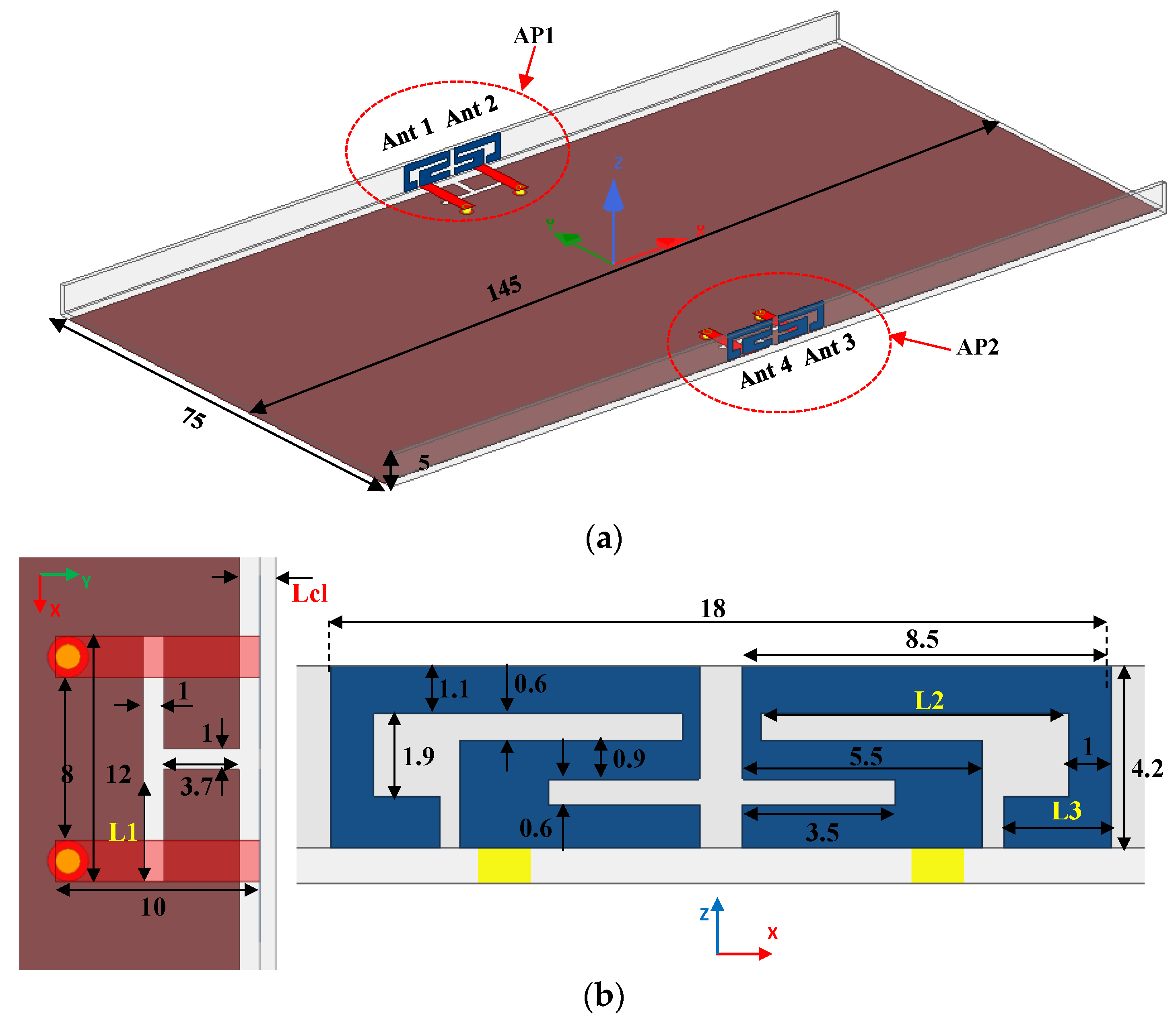
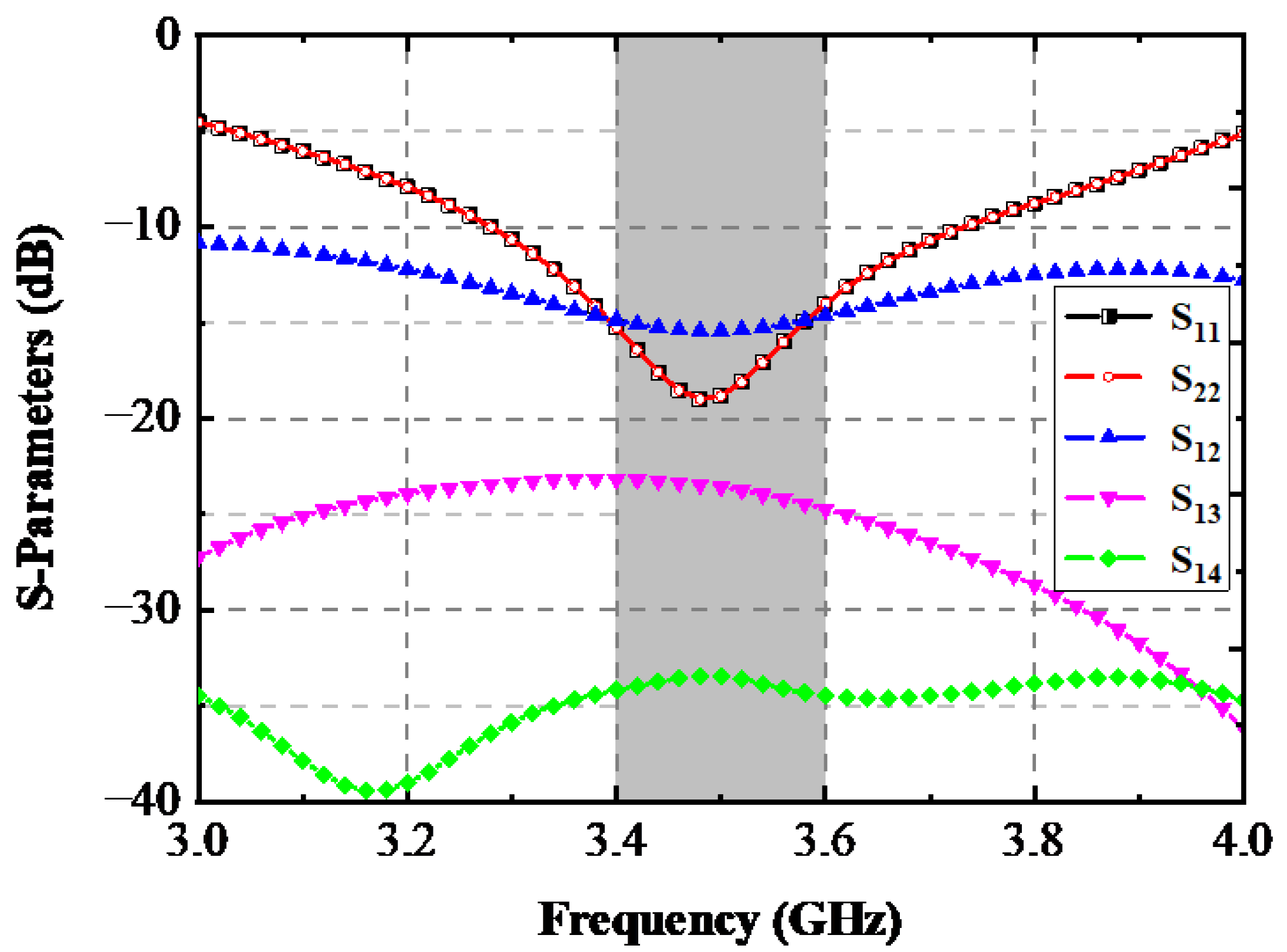
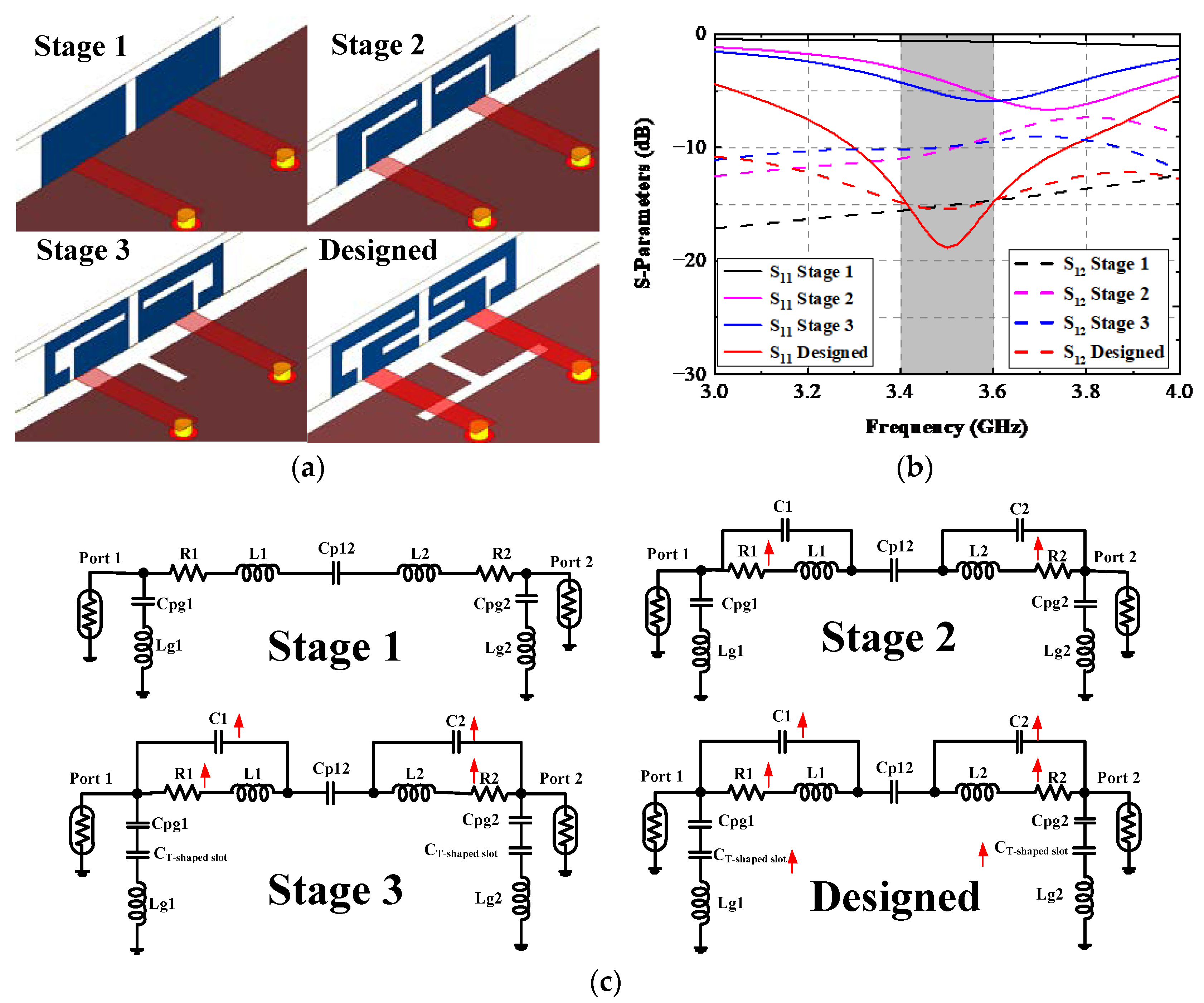
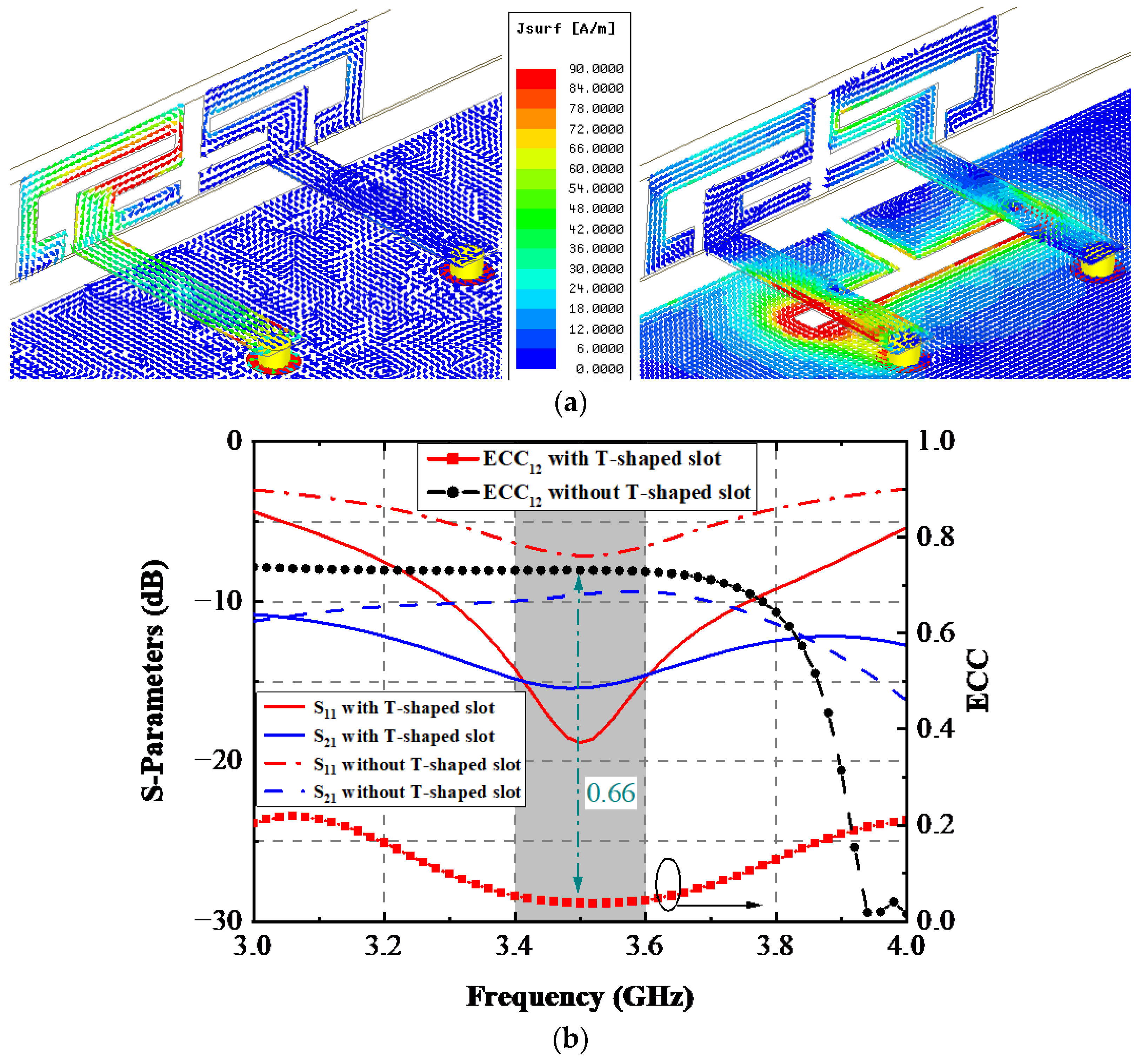
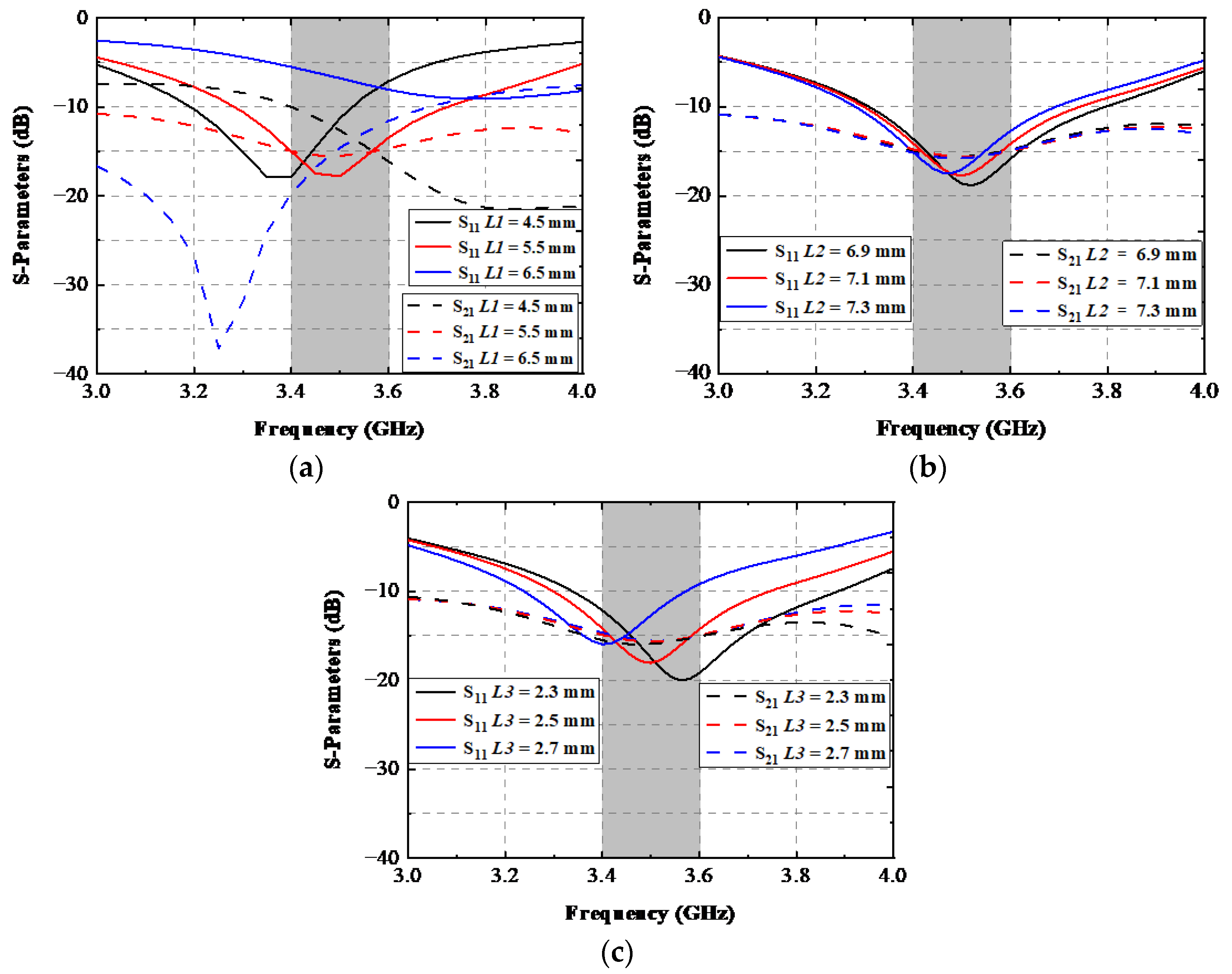
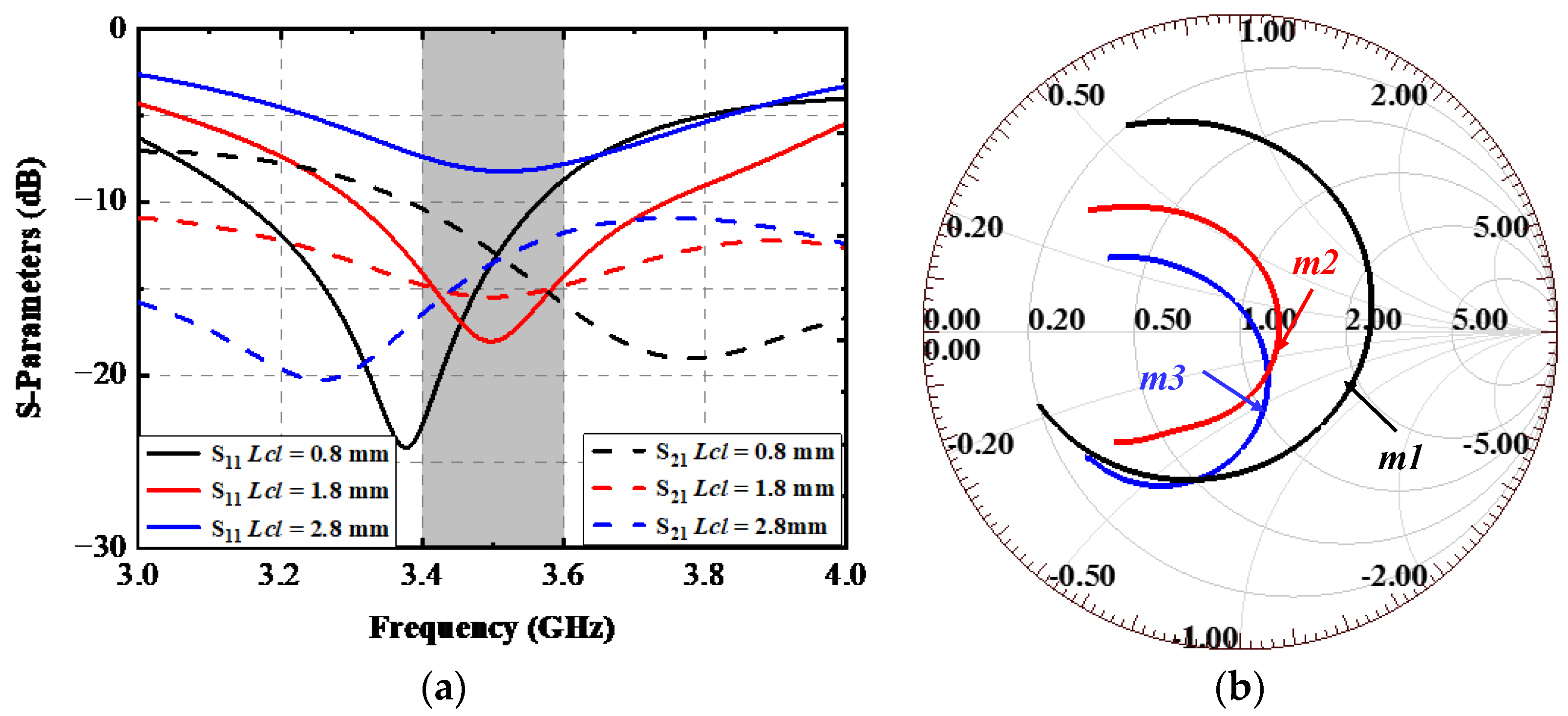
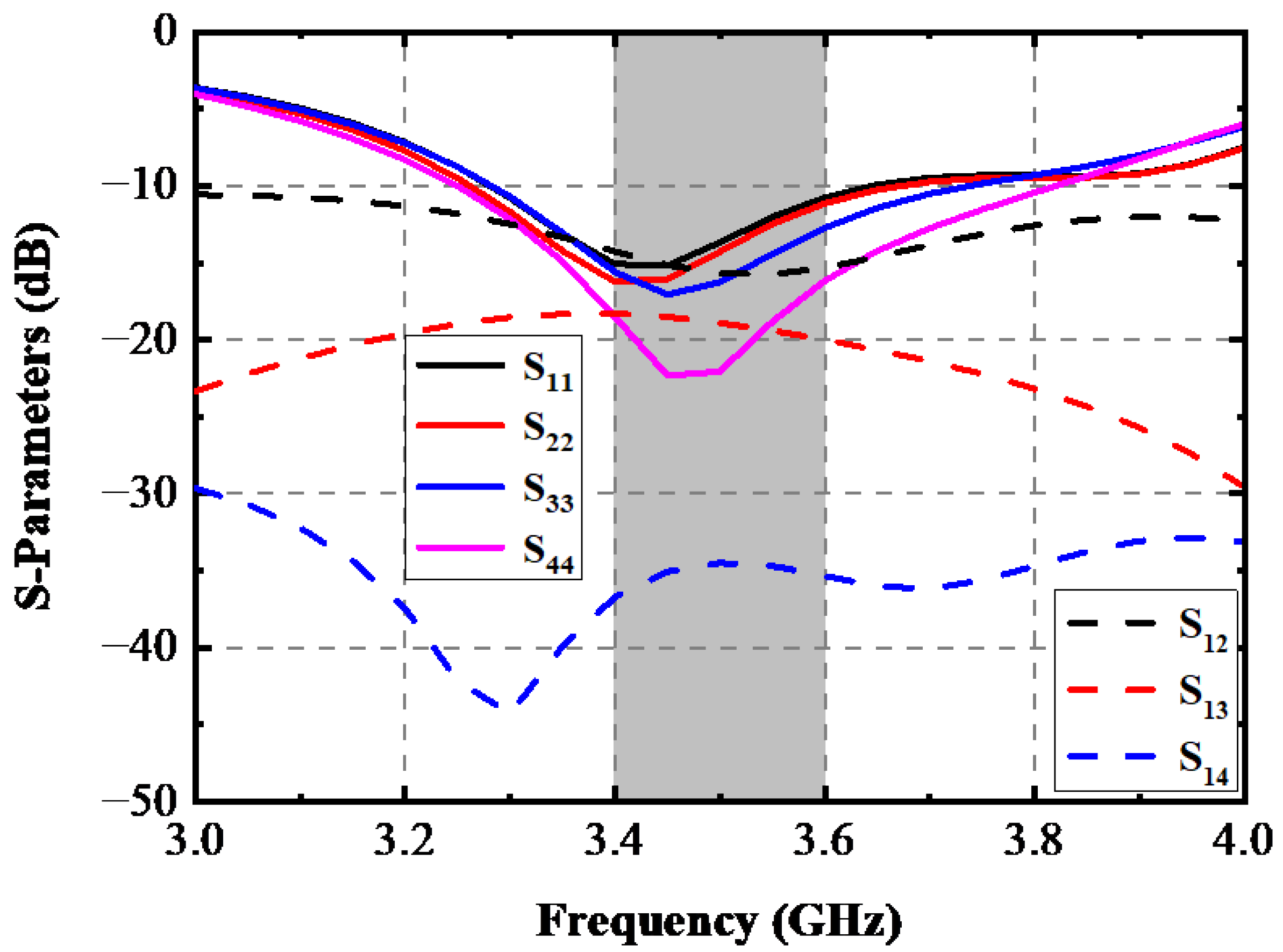
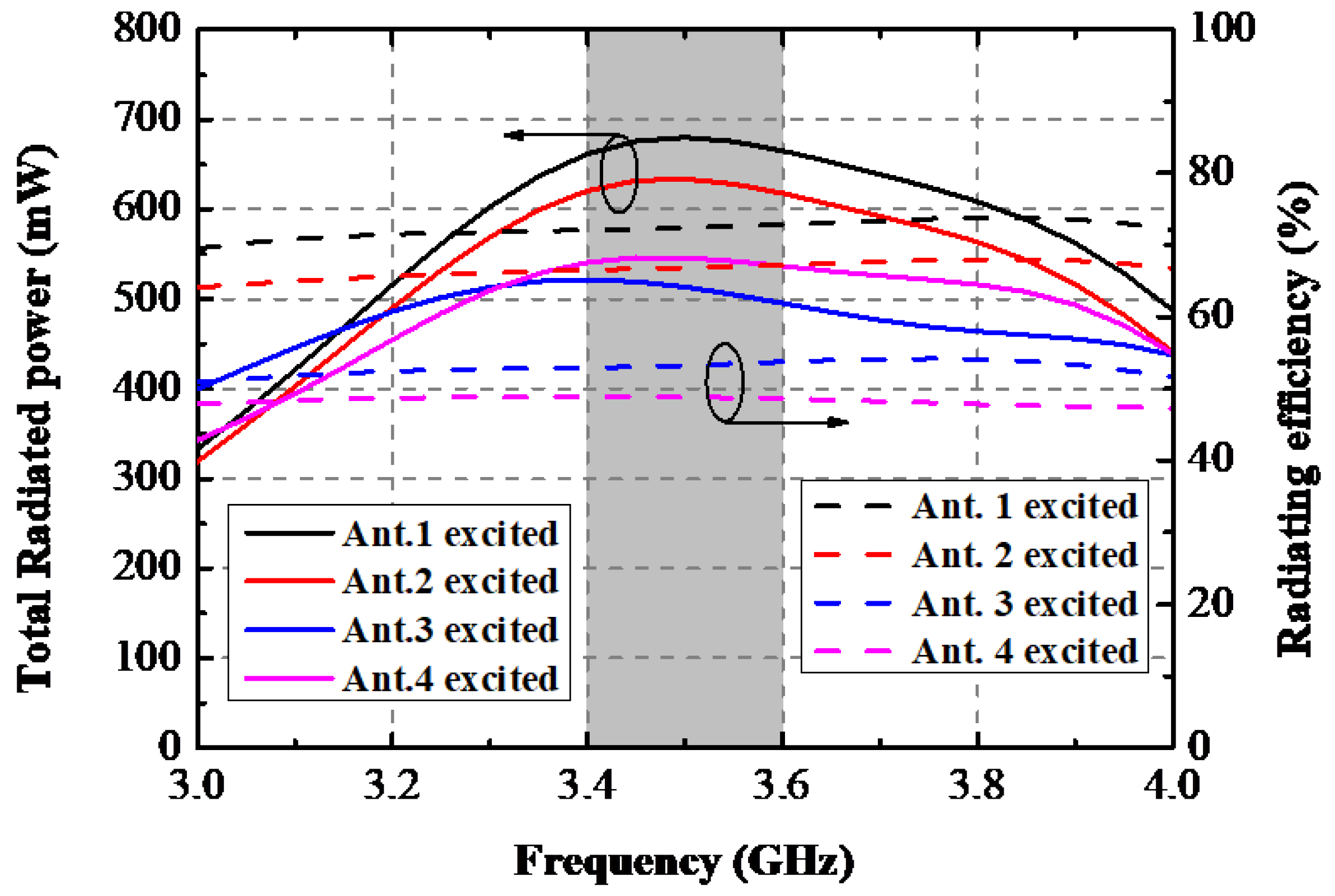

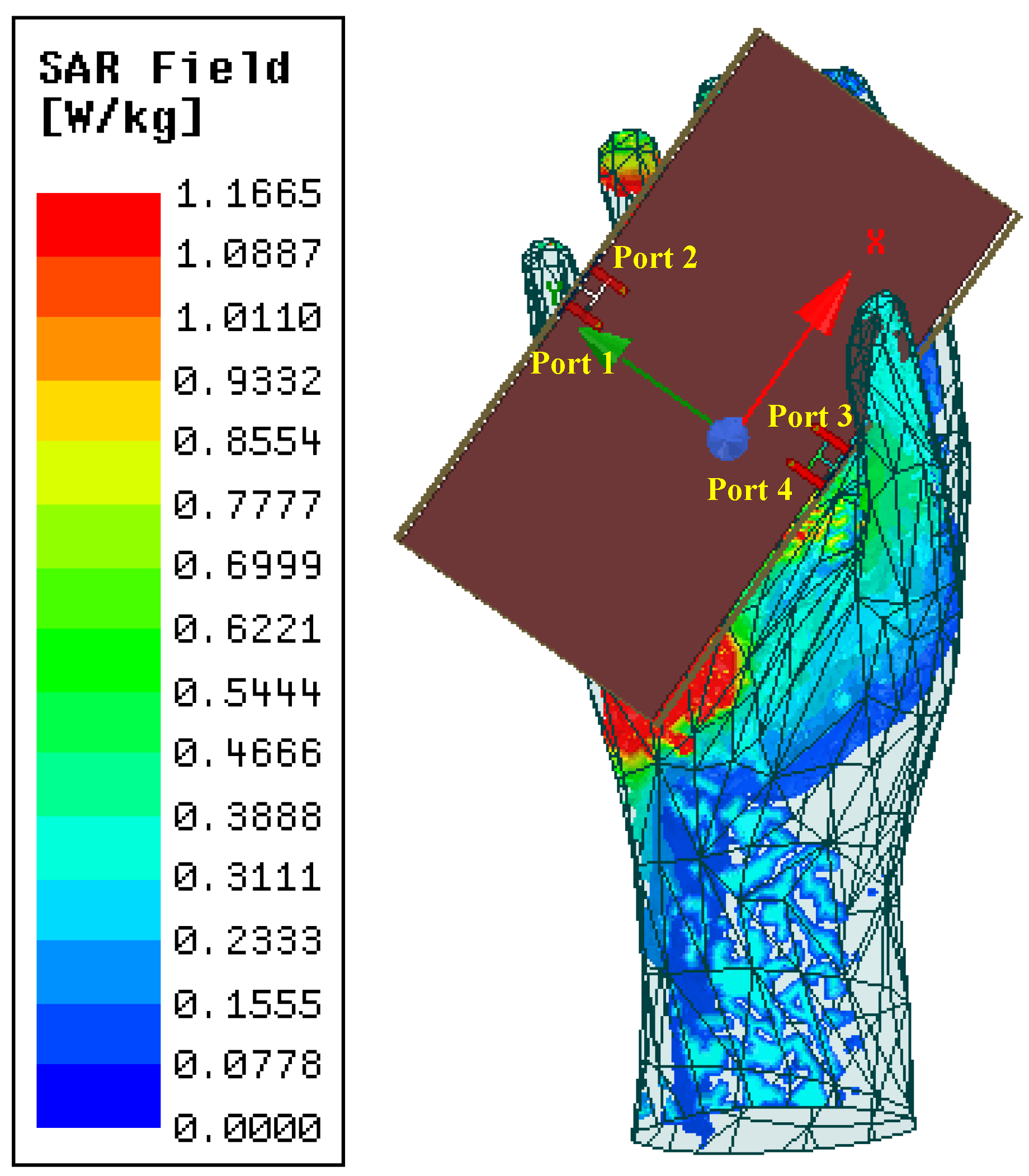
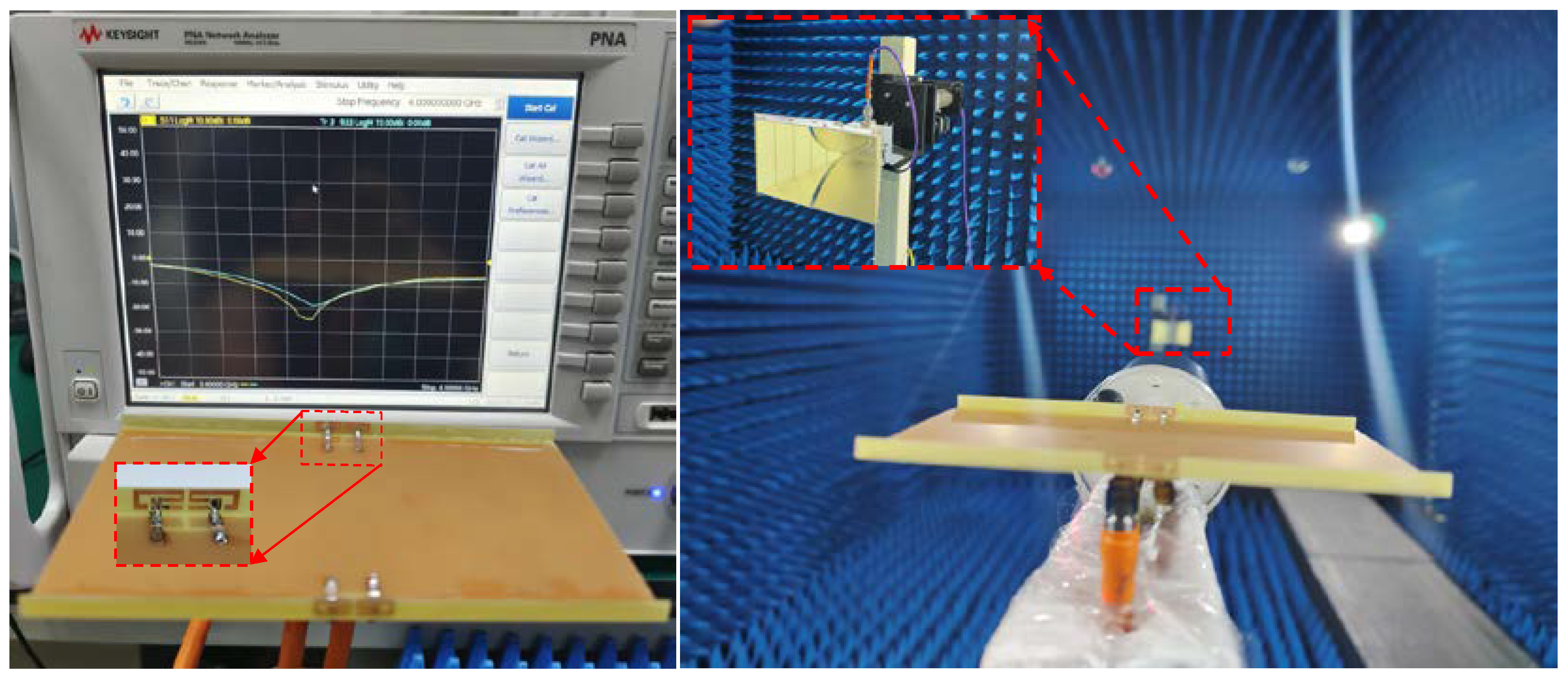

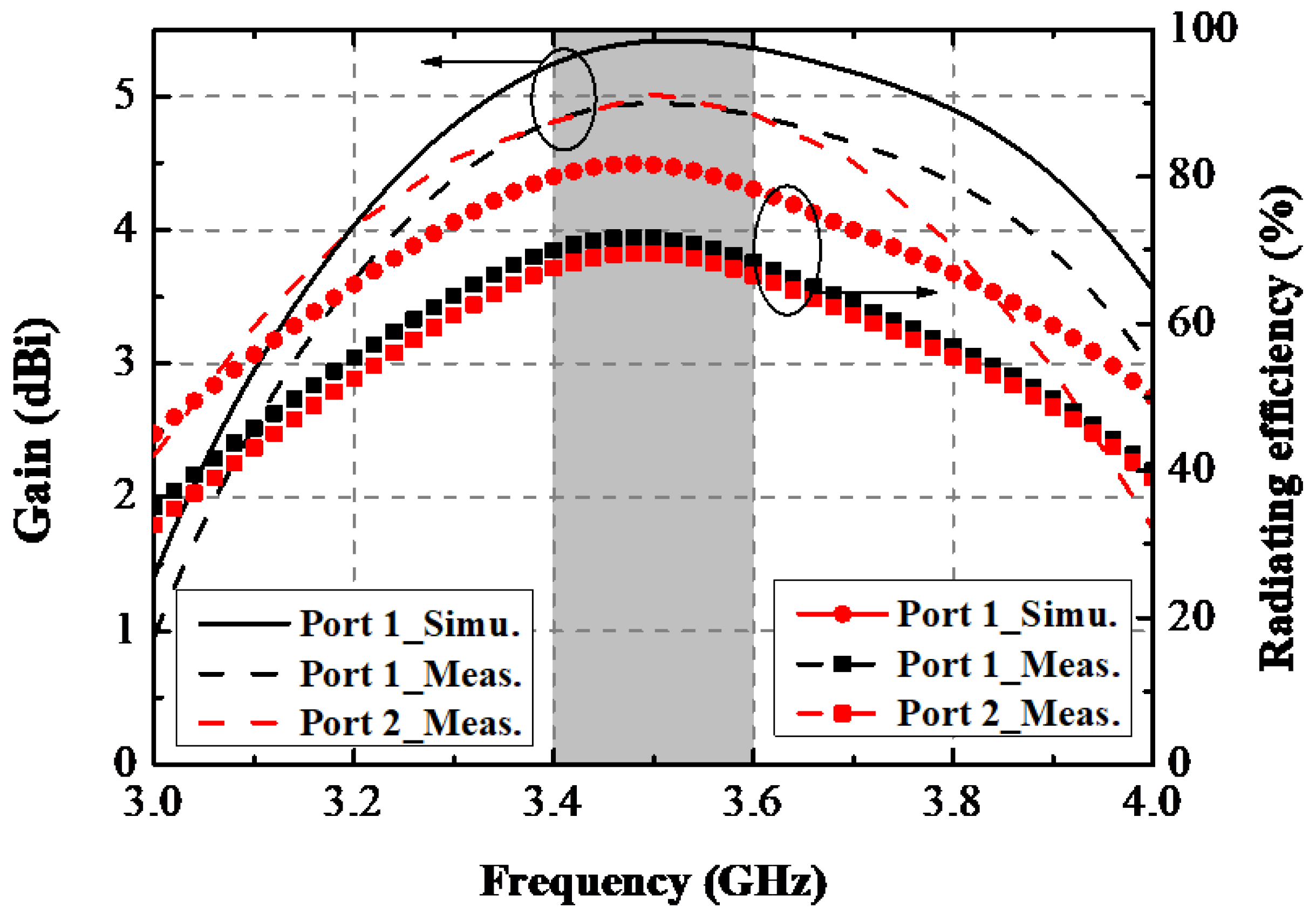

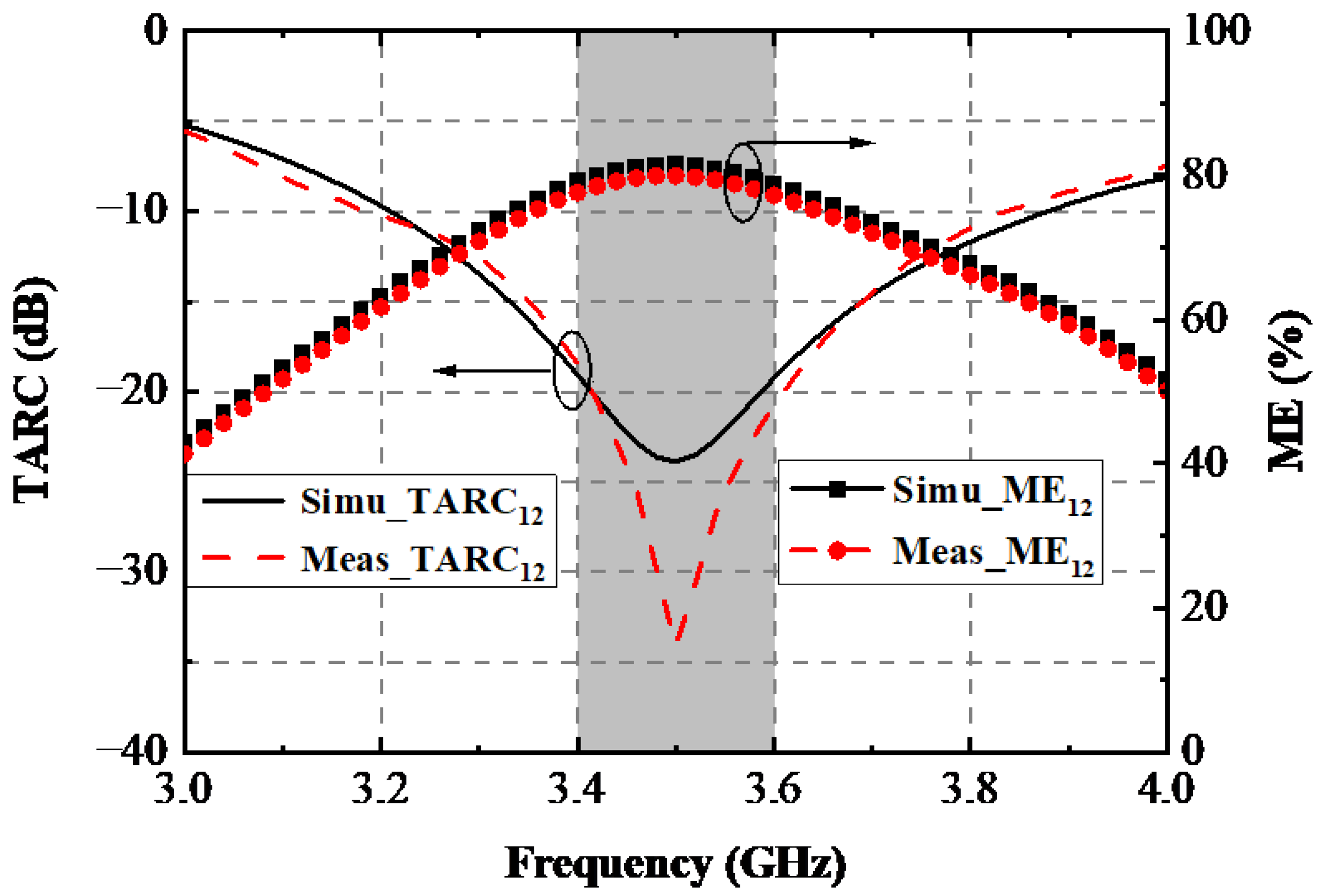
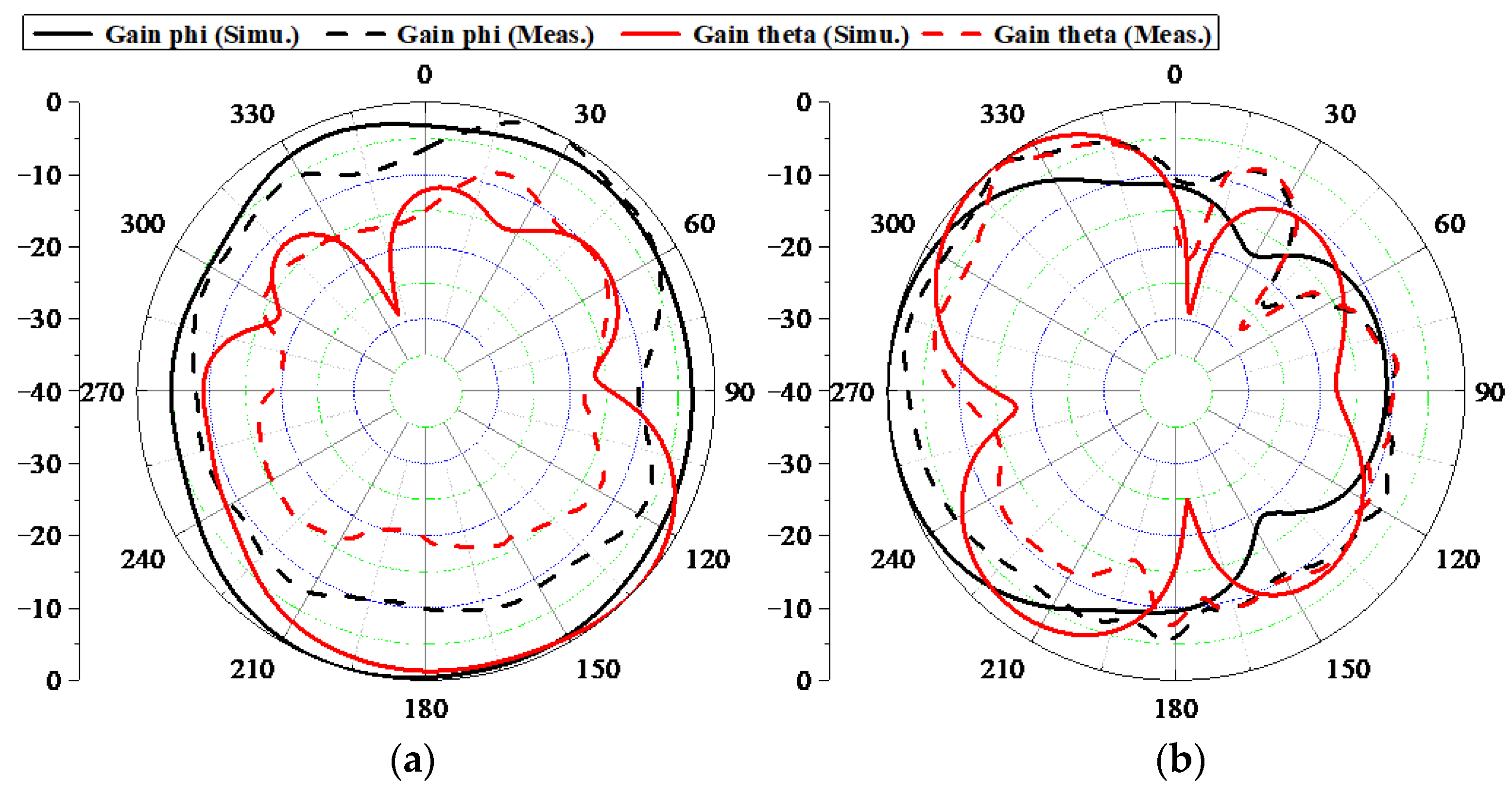

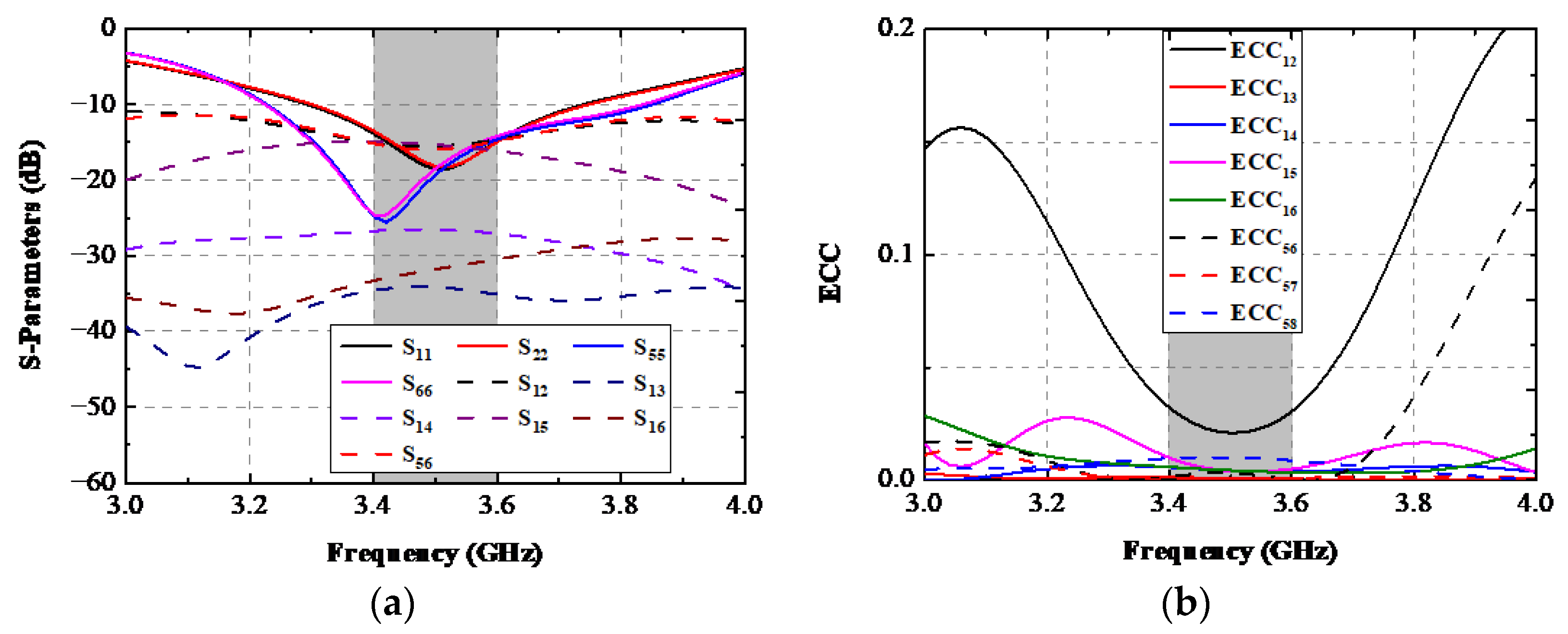
| Design | Operating Band (GHz) | Total Size (mm3) | Dimension of an AP (mm3) | Port Distance in an AP (mm) | Isolation (dB) | ECC |
|---|---|---|---|---|---|---|
| [12] | 3.4–3.6 (−10 dB) | 150 × 73 × 7 | 12 × 7 × 0.8 | 17 | 0.07 | |
| [15] | 3.4–3.6 (−10 dB) | 150 × 73 × 7 | 20 × 6.2 × 0.8 | 15.6 | 17 | 0.1 |
| [18] | 3.4–3.6 (−10 dB) | 150 × 75 ×6 | 23.5 × 5.2 × 0.8 | 11.7 | 17.5 | 0.009 |
| [19] | 3.4–3.6 (−10 dB) | 150 × 75 × 6 | 30 × 5.2 × 0.8 | 7 | 16.5 | 0.03 |
| This work | 3.34–3.65 (−10 dB) | 145 × 75 × 5 | 18 × 4.2 | 8 | 17 | 0.009 |
Publisher’s Note: MDPI stays neutral with regard to jurisdictional claims in published maps and institutional affiliations. |
© 2022 by the authors. Licensee MDPI, Basel, Switzerland. This article is an open access article distributed under the terms and conditions of the Creative Commons Attribution (CC BY) license (https://creativecommons.org/licenses/by/4.0/).
Share and Cite
Zhang, C.; Huang, J.; Shi, X.; Dong, G.; Cai, J.; Liu, G. A Compact Ultra-Thin 4 × 4 Multiple-Input Multiple-Output Antenna. Sensors 2022, 22, 6091. https://doi.org/10.3390/s22166091
Zhang C, Huang J, Shi X, Dong G, Cai J, Liu G. A Compact Ultra-Thin 4 × 4 Multiple-Input Multiple-Output Antenna. Sensors. 2022; 22(16):6091. https://doi.org/10.3390/s22166091
Chicago/Turabian StyleZhang, Chuanba, Jianlin Huang, Xiaojing Shi, Guiting Dong, Jing Cai, and Gui Liu. 2022. "A Compact Ultra-Thin 4 × 4 Multiple-Input Multiple-Output Antenna" Sensors 22, no. 16: 6091. https://doi.org/10.3390/s22166091






